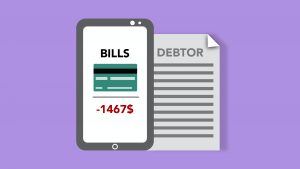How to Remove Derogatory Entries From Your Credit Report

What Are Derogatory Entries on Your Credit Reports?
The term derogatory simply means negative, so derogatory items on your credit report are any items that reflect negatively on your credit. In other words, they indicate that you have failed to make timely payments on your debt.
Derogatory entries can be divided into two categories: minor derogatories and major derogatories. They both can hurt your credit substantially and contribute to bad credit, but major derogatory items have a greater negative impact on your credit score than minor derogatory items.
Examples of Derogatory Items on Your Credit Reports
Minor Derogatory Entries
30-day late payments
60-day late payments
Major Derogatory Entries
90, 120, 150-day late payments, etc.
Charge-offs
Collections
Foreclosures
Settlements
Short sales
Repossessions
Public records (bankruptcies)
Read more about derogatory items and how they affect your credit score in this article.
A bankruptcy on your credit report counts as a major derogatory entry.
The Good News: You Can Dispute Inaccurate Derogatory Information on Your Credit Reports
As a consumer, you have the right to have your credit reports be accurate, as dictated by the Fair Credit Reporting Act (FCRA).
Therefore, if there is information on your credit reports that is wrong, then you have the right to ask for the incorrect information to be either corrected or removed from your credit reports.
In order to challenge inaccurate information on your credit reports, you can file a direct dispute with the party that furnishes your data to the credit bureaus (e.g. a lender, financial services company, debt collector, etc.) or an indirect dispute with the credit reporting agencies (CRAs).
If you choose to go the route of an indirect dispute, you contact the CRAs about the problematic information and they then investigate the dispute with the company that is furnishing the data.
You can use either type of dispute to ask for the inaccurate derogatory information on your credit report to be corrected or deleted altogether.
The Bad News: You Do Not Have the Right to Have Accurate Negative Information Removed From Your Credit Reports
According to the FCRA, accurate and verifiable negative information can remain on your credit reports for up to seven years.
Unfortunately, that means if the derogatory information on your credit reports is accurate and verifiable, then the CRAs are under no obligation to remove it before the 7-year clock runs out.
Derogatory information that is accurate and verifiable can stay on your credit report for up to seven years.
How to Dispute Derogatory Entries on Your Credit Reports
It is free to dispute inaccurate information on your credit reports, and you can do this process yourself. Another option is to hire a reputable credit repair company to do this work on your behalf.
If you choose to complete the dispute process yourself, you can do this in a few different ways:
Go to the CRAs’ websites and file your dispute online
Equifax.com
TransUnion.com
Experian.com
Mail your dispute through the postal services
Contact the CRAs over the phone
Dispute the information directly with the furnishing party
You can submit your disputes online on the CRAs’ websites.
Which Dispute Method is Most Effective?
While there is not necessarily a “best” way to file a dispute, often, plaintiff’s lawyers advise consumers to file their disputes with the credit bureaus because this method may leave you in a better positioned to take legal action if the credit bureaus fail to remove the incorrect information.
The Benefits of Disputing Directly With the Furnishing Party
When you file a direct dispute with the company that is furnishing the inaccurate information to the credit bureaus, you are addressing the information at its source. For this reason, the data furnisher has an obligation to correct the error with all of the CRAs they report to.
If a mistake is showing up on more than one of your credit reports, the direct dispute strategy can save you some time since you are only filing one dispute to have the information corrected on each of your credit reports where it is applicable.
Working With a Credit Repair Company to Remove Derogatory Information
Although the consumer credit dispute process is free to use, some consumers may choose to work with a credit repair company to accomplish their goals.
In this case, the credit repair company goes through the dispute process on your behalf.
While a credit repair organization cannot charge you in advance of providing a service as per the Credit Repair Organizations Act (CROA), if they successfully get the information corrected or removed, they can then charge you for this service that has been fully performed.
How Do You Know if You Need to Dispute Incorrect Information on Your Credit Reports?
To find out if there are errors on your credit reports, you need to get copies of your own reports.
Typically, you can do this for free once every 12 months with each of the three credit bureaus. However, due to the COVID-19 pandemic, the CRAs have made it easier to check your credit more often by making it free to check your credit reports every week until April 20, 2022.
To order your free credit reports, go to annualcreditreport.com, which is the only website that is federally authorized to provide your free credit reports, and request them there.
How Long Does the Dispute Resolution Process Take?
The credit bureaus are technically allowed to take 30 days to complete their dispute investigation process, but this rule is decades old. These days, with the technology we have now, it is more likely that your dispute will be resolved in only 10-14 days.
Consumer disputes are usually resolved within two weeks.
We hope this article has been informative for those wondering about how to get derogatory information removed from your credit reports! To learn more about how to use credit report disputes effectively, check out our article on How to Fix the Most Common Credit Report Errors.
Want to see the video version of this article, featuring credit expert John Ulzheimer? Watch it below and then subscribe to our channel on YouTube to see more helpful videos about the credit system!
Read more: tradelinesupply.com





 In credit reporting,
In credit reporting, 
 The “opt-out” myth is one of many
The “opt-out” myth is one of many  Everyone wants to get a higher credit score, but not all of the “
Everyone wants to get a higher credit score, but not all of the “
 We’ve written before about the problem of
We’ve written before about the problem of 

 When you are paying for purchases, is it better to use a debit card or a
When you are paying for purchases, is it better to use a debit card or a 
 The “date of last activity,” also known as the DLA, is often discussed within the field of
The “date of last activity,” also known as the DLA, is often discussed within the field of 
 Secured credit and unsecured credit are types of credit that are very different in terms of risk to consumers and lenders.
Secured credit and unsecured credit are types of credit that are very different in terms of risk to consumers and lenders.
 Did you know that sometimes
Did you know that sometimes 